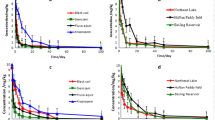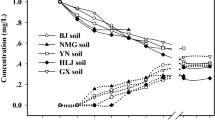Abstract
Quinestrol has shown potential for use in the fertility control of the plateau pika population of the Qinghai–Tibet Plateau. However, the environmental safety and fate of this compound are still obscure. Our study investigated degradation of quinestrol in a local soil and aquatic system for the first time. The results indicate that the degradation of quinestrol follows first-order kinetics in both soil and water, with a dissipation half-life of approximately 16.0 days in local soil. Microbial activity heavily influenced the degradation of quinestrol, with 41.2 % removal in non-sterile soil comparing to 4.8 % removal in sterile soil after incubation of 10 days. The half-lives in neutral water (pH 7.4) were 0.75 h when exposed to UV light (λ = 365 nm) whereas they became 2.63 h when exposed to visible light (λ > 400 nm). Acidic conditions facilitated quinestrol degradation in water with shorter half-lives of 1.04 and 1.47 h in pH 4.0 and pH 5.0 solutions, respectively. Moreover, both the soil and water treatment systems efficiently eliminated the estrogenic activity of quinestrol. Results presented herein clarify the complete degradation of quinestrol in a relatively short time. The ecological and environmental safety of this compound needs further investigation.






Similar content being viewed by others
References
Arthur AD, Pech RP, Jiebu, Zhang Y, Lin H (2007) Grassland degradation on the Tibetan Plateau: the role of small mammals and methods of control. ACIAR Technical Reports. No. 67, ACIAR, Canberra
Arthur AD, Pech RP, Davey C, Jiebu, Zhang Y, Lin H (2008) Livestock grazing, plateau pikas and the conservation of avian biodiversity on the Tibetan plateau. Biol Conserv 141:1972–1981
Chowdhury RR, Charpentier PA, Ray MB (2011) Photodegradation of 17 beta-estradiol in aquatic solution under solar irradiation: kinetics and influencing water parameters. J Photochem Photobiol A 219:67–75
Chu W, Jia J (2009) The photodegradation and modeling of a typical NAPL, trichloroethene, by monochromatic UV irradiations. Environ Sci Technol 43:1455–1459
Das BS, Lee LS, Rao PSC, Hultgren RP (2004) Sorption and degradation of steroid hormones in soils during transport: column studies and model evaluation. Environ Sci Technol 38:1460–1470
Fan NC, Zhou WY, Wei WH, Wang QY, Jiang YJ (1999) Rodent pest management in Qinghai–Tibet alpine meadow ecosystem. In: Singleton GR, Hinds LA, Leirs H, Zhang Z (eds) Ecologically-based management of rodent pests. Australian Centre for International Agricultural Research, Canberra, pp. 285–304
Greenblatt RB (1967) One-pill-a-month contraceptive. Fertil Steril 18:209–211
Hanselman TA, Graetz DA, Wilkie AC (2003) Manure-borne estrogens as potential environmental contaminants: a review. Environ Sci Technol 37:5471–5478
Jacobson AM, Lorenzen A, Chapmen R, Topp E (2005) Persistence of testosterone and 17 beta-estradiol in soils receiving swine manure or municipal biosolids. J Environ Qual 34: 861–871
Jürgens MD, Holthaus KIE, Johnson AC, Smith JJL, Hetheridge M, William RJ (2001) The potential for estradiol and ethinylestradiol degradation in English rivers. Environ Toxicol Chem 21:480–488
Knapp CW, Cardoza LA, Hawes JN, Wellington EMH, Larive CK, Graham DW (2005) Fate and effects of enrofloxacin in aquatic systems under different light conditions. Environ Sci Technol 39:9140–9146
Knipling EF (1959) Sterile male method of population control. Science 130:902–904
Lai CH, Smith AT (2003) Keystone status of plateau pikas (Ochotona curzoniae): effect of control on biodiversity of native birds. Biol Conserv 12:1901–1912
Layton AC, Gregory BW, Seward JR, Schultz TW, Sayler GS (2000) Mineralization of steroidal hormones by biosolids in wastewater treatment systems in Tennessee USA. Environ Sci Technol 34:3925–3931
Lee LS, Strock TJ, Sarmah AK, Rao PSC (2003) Sorption and dissipation of testosterone, estrogens and their primary transformation products in soils and sediment. Environ Sci Technol 37:4098–4105
Liang J (1981) On the restoration of population density of plateau pikas and common Chinese zokors after control. In: Xia W (ed) Alpine meadow ecosystem, fasc. 1. Gansu People’s Press, Lanzhou, pp 93–100
Lin AYC, Reinhard M (2005) Photodegradation of common environmental pharmaceuticals and estrogens in river water. Environ Toxicol Chem 24:1303–1309
Lorenzen A, Chapman R, Hendel JP, Topp E (2005) Persistence and pathways of testosterone dissipation in agricultural soil. J Environ Qual 34:854–860
Ma M, Li J, Wang ZJ (2005) Assessing the detoxication efficiencies of wastewater treatment processes using a battery of bioassays/biomarkers. Arch Environ Contam Toxicol 49:480–487
Nogales B, Aguilo-Ferretjans MM, Martin-Cardona C, Lalucat J, Bosch R (2007) Bacterial diversity, composition and dynamics in and around recreational coastal areas. Environ Microbiol 9:1913–1929
Payne JP, Rajapakse NA, Wilkins M, Kortenkamp A (2000) Prediction and assessment of the effects of mixtures of four xenoestrogens. Environ Health Perspect 108:983–987
Pech RP, Jiebu, Arthur AD, Zhang Y, Lin H (2007) Population dynamics and responses to management of plateau pikas (Ochotona curzoniae). J Appl Ecol 44:615–624
Shi JH, Fujiwara S, Nakai S, Hosomi M (2004) Biodegradation of natural and synthetic estrogens by nitrifying activated sludge and ammonia-oxidizing bacterium Nitrosomonas europaea. Water Res 38:2323–2330
Smith AT, Foggin JM (1999) The plateau pika (Ochotona curzoniae) is a keystone species for biodiversity on the Tibetan plateau. Anim Conserv 2:235–240
Sui YY, Jiao XG, Gao CS, Chen W, Zhang XY, Liu XB (2009) The relationship among organic matter content and soil microbial biomass and soil enzyme activities. Chin J Soil Sci 40:1036–1039
Wang Q, Jing Z, Wang W, Lang B, Ma Y, Jiang W (1997) The study of grassland resource, ecological environment and sustainable development in Qinghai–Xizang plateau. Qinghai Prataculture 7:1–11
Wang C, Zhang Q, Zhang XF, Liu J, Liu WP (2010) Understanding the endocrine disruption of chiral pesticides: the enantioselectivity in estrogenic activity of synthetic pyrethroids. Sci China-Chem 53: 1003–1009
Zhang ZB (2000a) Advances of immune-contraception in vertebrate pest management in Australia. Acta Theriol Sin 20:130–134
Zhang ZB (2000b) Mathematical models of wildlife management by contraception. Ecol Model 132:105–113
Zhang Y, Fan N, Wang Q, Jing Z (1998) The changing ecological process of rodent communities during rodent pest managements on alpine meadow. Acta Theriol Sin 18:137–143
Zhao MR, Liu M, Li D, Wan XR, Lyn AH, Wang YL, Zhang ZB (2007) Anti-fertility effect of levonorgestrel and quinestrol in Brandt’s voles (Lasiopodomys brandtii). Integr Zool 2:260–268
Zheng D, Li BY (1999) Progress in studies on geographical environments of the Qinghai–Xizang Plateau. Sci Geogr Sin 19:295–302
Zhong WQ, Wang MJ, Wan XR (1999) Ecological management of Brandt’s vole (Microtus brandti) in Inner Mongolia, China. In: Singleton G, Hinds L, Leirs H, Zhang Z (eds) Ecologically-based management of rodent pests. Australian Centre for International Agricultural Research, Canberra, pp 199–214
Acknowledgments
This study was financially supported by the National Basic Research Program of China (2009CB109100), National Natural Science Foundation of China (41071314), and China Postdoctoral Science Foundation Funded Project (2013T60599).
Author information
Authors and Affiliations
Corresponding author
Additional information
Responsible editor: Leif Kronberg
Rights and permissions
About this article
Cite this article
Zhang, Q., Wang, C., Liu, W. et al. Degradation of the potential rodent contraceptive quinestrol and elimination of its estrogenic activity in soil and water. Environ Sci Pollut Res 21, 652–659 (2014). https://doi.org/10.1007/s11356-013-1941-1
Received:
Accepted:
Published:
Issue Date:
DOI: https://doi.org/10.1007/s11356-013-1941-1




